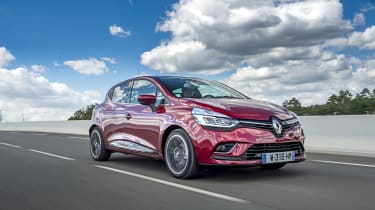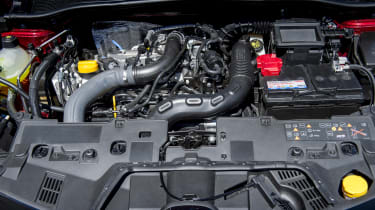Renault Clio review - updated supermini still a fine choice - Renault Clio engine and gearbox
Chic Renault Clio has verve, but isn’t class-leader
There's a fairly decent selection of both petrol and diesel models in the Clio range. Petrol models comprise an entry-level 1.2 16v 75 (with 74bhp and 79lb ft of torque) and two turbocharged petrol engines - the 898cc TCe 90, and the 1.2-litre TCe 120. Those numbers refer to each car's metric horsepower; in good old-fashioned imperial horses you're looking at 89bhp and 118bhp, with 103lb ft of torque at 2500rpm in the former and 151lb ft at 2000rpm in the latter.
The TCe 120 is also available with two transmissions: A six-speed manual and a six-speed Efficient Dual Clutch (EDC) automatic. The manual has arrived due to popular demand; previously, the top-end TCe was only available with the EDC. It's all the better with the manual, since the auto's shifts aren't the swiftest and the manual has a nice, light and fairly accurate action, improved upon its predecessor thanks to new carbon synchromesh rings in the 'box itself and new pendulum weights for the linkage.
Neither feels particularly strong however, and we suspect the four-pot might need more miles under its wheels to loosen up a little at the top end. The TCe 90 is manual-only - a five-speeder. Ditto the 1.2 16v, but frankly that one's best left well alone.
Diesel models include the 1.5-litre, four-cylinder dCi 75, dCi 90 and dCi 110. That's 74bhp, 89bhp and 108bhp in old money, with each car's torque peak of 148lb ft, 162lb ft and 192lb ft developed at the same 1750rpm. That gives a clue as to how each car drives, doing its best (read: strongest and quietest) work for a short period after that torque peak.
The dCi 75 gets a five-speed manual. The 90 has a choice of 5-speed manual or 6-speed EDC, and the dCi 110 gets a six-speed manual.
The 1.5 will rev smoothly enough to the red line if you so require but there's little joy to be had in doing so, and regardless of power output the focus here is on easy-going performance and modest speeds. If you fondly remember the large swell of torque that turbodiesels used to produce, this isn't the engine for you. The cabin and controls are well insulated against diesel noise and vibration though.
All models in Dynamic Nav grade and above feature an Eco mode, which reduces engine torque and modifies throttle response for 'optimised efficiency'. In our experience these models make cars pretty turgid to drive.




